| FAQ |
| Members List |
| Social Groups |
| Calendar |
| Search |
| Today's Posts |
 |
|
| Pontiac - Boost Turbo, supercharged, Nitrous, EFI & other Power Adders discussed here. |
| Reply |
|
|
Thread Tools | Display Modes |
 |
|
| Pontiac - Boost Turbo, supercharged, Nitrous, EFI & other Power Adders discussed here. |
| Reply |
|
|
Thread Tools | Display Modes |
|
#1
|
||||
|
||||
|
I saw this in a turbo thread i think on py. Does anyone have any experience with this system or any knowledge of it? It looks to have a lot of good features for a reasonable cost. I wonder if the quality is there.
http://fitechefi.com/default.asp.pg-...m8-InjectorKit |
|
#2
|
||||
|
||||
|
Looks like it isn't out yet. The web site says PRE-ORDER for $50 which will be applied to the final cost of $1495 + tax in Ca.
Sounds interesting though......
__________________
No! Do not try! Do! Or do not. There is no try. - Yoda 1967 Firebird Restoration 2005 - 1/25/2017 
|
|
#3
|
|||
|
|||
|
We just ordered one for a large bore LS motor that I am building for a neighbor's ProTouring Camaro. He had a bad experience with a previous LS swap using the factory ECU, and wanted to run a carbed LS for his new project. He has decided to try this system instead of the carb.
We're told to expect delivery in two weeks. We saw Mike Sullivan's El Camino run the Good Guys Auto X last month using the 600 HP version, and it ran quite well. Rob McGregor at No Limits Engineering also put one on his car and has had good results. Keep in mind these are pre-production units, and no long term reliability data exists that I know of. Both of these guys are experienced EFI guys, and they have positive feedback so far. When we get the motor together, we'll be taking it over to Westech's engine dyno. Time permitting, we will also do a carb pull to see if there are differences. I'll report back the results at that time. The system reportedly has on-board spark control, so we'll see how that works out as well.
__________________
1964 Catalina 2+2 4sp, 421 Tri-power 1965 GTO, Roadster Shop chassis, 461, Old Faithful cam, KRE heads 305 CFM, Holley EFI, DIS ignition. 1969 GTO 467, Edelbrock 325 CFM, Terminator EFI 1969 Firebird Convertible |
|
#4
|
||||
|
||||
|
Can you post your results when you get the engine on the dyno? I am very interested in doing this upgrade over the next winter.
|
|
#5
|
|||
|
|||
|
Well we don't have the dyno yet, but we did receive the production unit and I thought I'd post some pics and comments.
We ended up with the 1200 HP version, as the 600 HP version is likely to be too small for the 441 CID LS7 based motor this is going on. The 1200 HP unit has 8 injectors, the 600 HP unit has 4 injectors. The injectors are staged sequentially, so you can run a 1200 HP unit on a motor with much less HP without overwhelming the injectors at idle. The company claims to have a 1200 HP unit running on a 350 HP motor with no issues. This might be helpful for a future boost application that can run on motor only for as long as necessary, until funds permit a power adder. I would think that even 600 HP version would be an excellent candidate for a Qjet replacement for many Pontiacs. So far I am pretty impressed with the quality and simplicity of the unit. Maybe I can share some comments for those considering this for a Pontiac engine, as there are very few of these EFI units out in the field. I have no affiliation with the company. The ECU and many of the sensors are mounted inside the throttle body housing. The 600 HP unit is designed to work with the vehicles stock low pressure fuel pump, and in this case uses an optional fuel sump tank mounted in the engine compartment, which has an auxiliary high pressure fuel pump. This is a pretty big advantage to a retrofit, as the cost to replace a complete low pressure fuel system to modern EFI pressure levels can be quite costly on most muscle cars. The 1200 HP unit requires a modern high pressure fuel system. Both units can support spark control for CDI and other types of ignition, even conventional distributor, if desired. In these cases, the traditional vacuum or mechanical advance is locked out, and the EFI supplies programmable timing control. HEI is not supported. Or you can leave the distributor completely stock and ignore the EFI for spark. In this case it is truly a carb replacement. The fuel regulator is located inside the throttle body, it is set at 58 psi, and is not adjustable. The system is speed density, and also has an embedded MAP sensor. An IAC control is supplied for idle adjustment. The ECU requires a tach input from the coil to communicate RPM. The system comes with a single Bosch O2 sensor, with a plug and play harness, as well as a bung to weld into the exhaust collector. 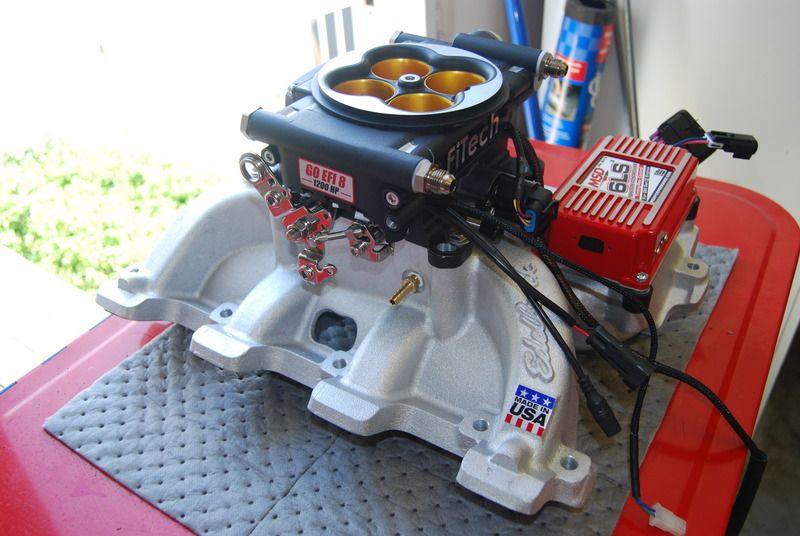 The unit can be seen (above) mocked up on a Edelbrock dual plane intake, with an MSD box. In this case as there is no distributor, the MSD unit provides full programmable spark control to the 8 LS coils. The MSD takes a vacuum signal from a MAP sensor, and timing inputs from the LS 58 tooth outputs. 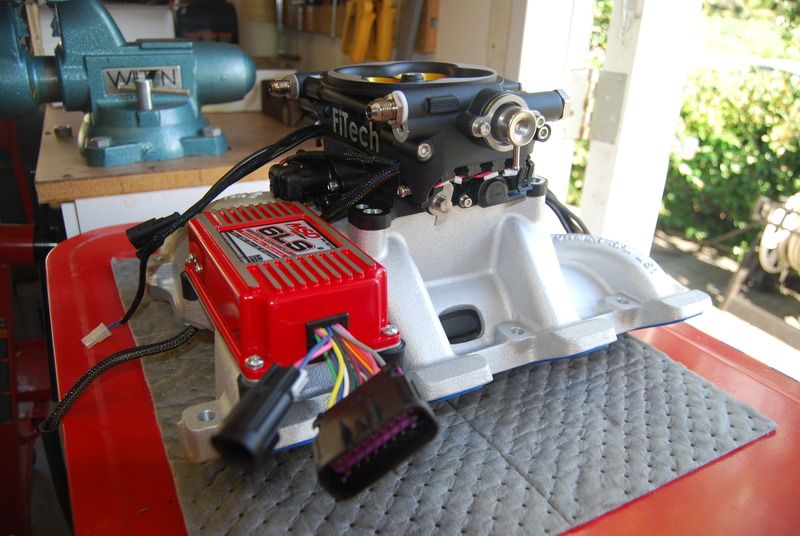 Passenger side view above. 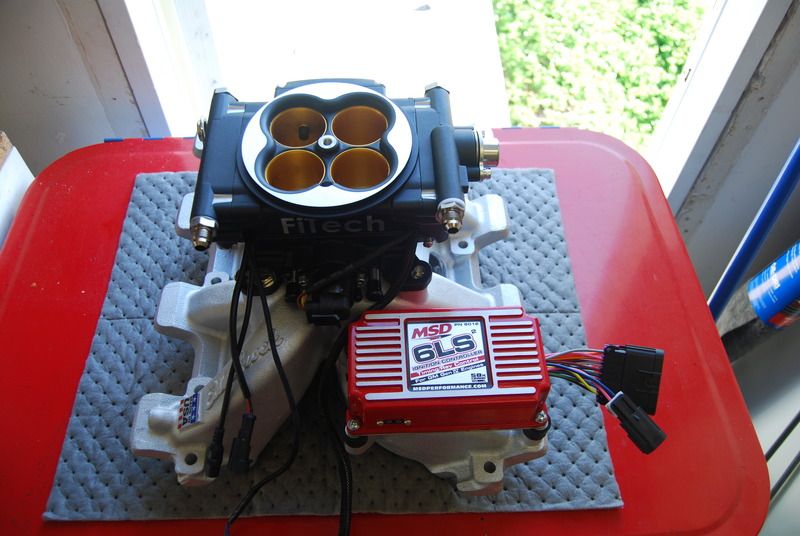 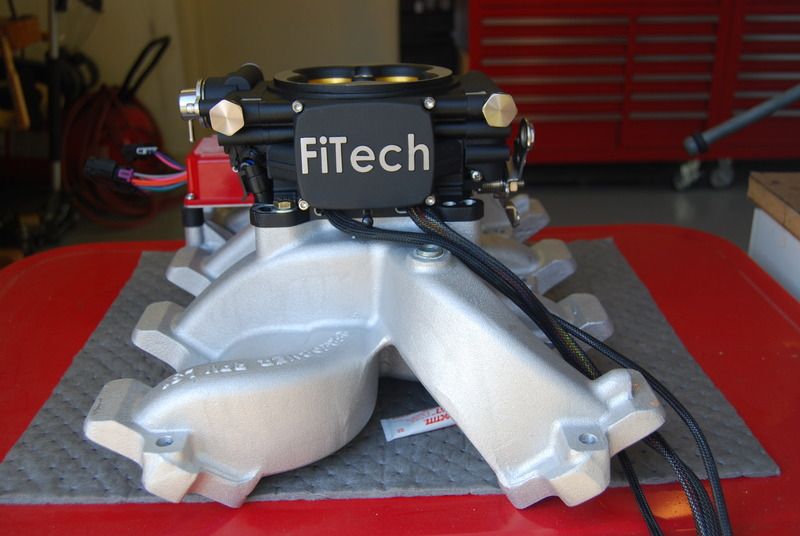 Front view above. 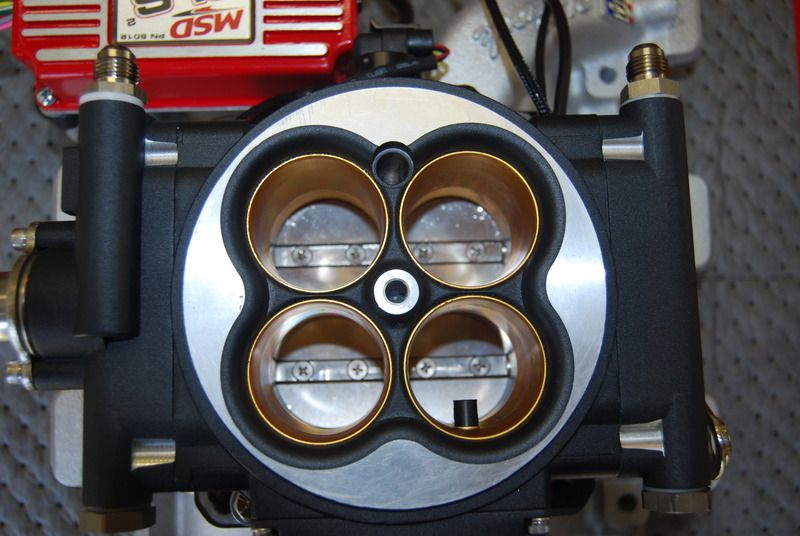 Top View. The injector nozzles are annular discharge type, and are just above the butterfly plates. It's too soon to say how this will work out, but so far it looks good to me and the value is certainly there especially for the 600 HP version. I'll post again when dyno results are available. If anyone is curious, here are the heads that this EFI is going on, these CNC cathedral ports flow 360 CFM @ .650 lift.  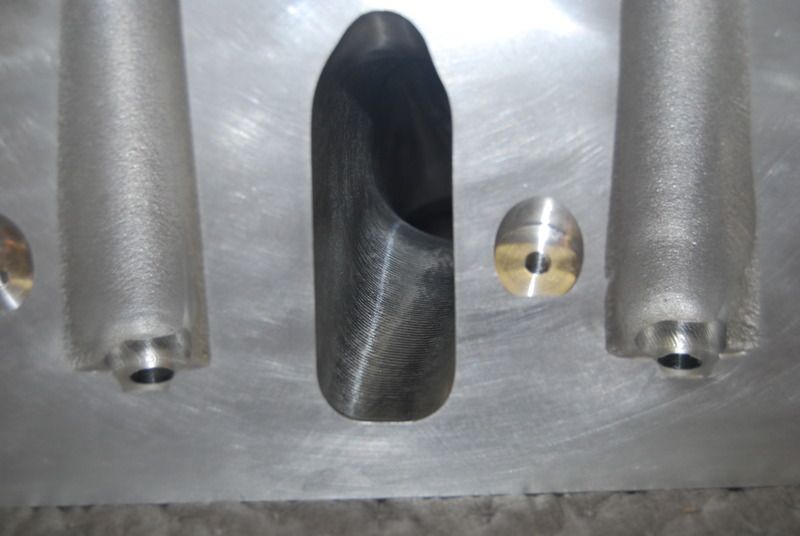
__________________
1964 Catalina 2+2 4sp, 421 Tri-power 1965 GTO, Roadster Shop chassis, 461, Old Faithful cam, KRE heads 305 CFM, Holley EFI, DIS ignition. 1969 GTO 467, Edelbrock 325 CFM, Terminator EFI 1969 Firebird Convertible |
|
#6
|
||||
|
||||
|
Wow. That looks awesome. I just spent some time looking at the website, and I am impressed by what I read.
I thought the fuel surge tank was a cool piece. Everything I was reading said "cool as ***". I hope actual performance equals my excitement level. The price point seems killer too. Like if the performance and reliability come through, this could be a game changer. I will be following this.
__________________
"...ridge reamer and ring compressor? Do they have tools like that?" |
|
#7
|
||||
|
||||
|
Thank you for the update. Let us know how it performs. I know if there are good results i will be getting one of these systems soon.
|
|
#8
|
||||
|
||||
|
I found this on the web.
Engine is SBC, was running Edelbrock carb until the conversion. http://www.corvetteforum.com/forums/...fi-review.html Solid write up.
__________________
"...ridge reamer and ring compressor? Do they have tools like that?" |
|
#9
|
||||
|
||||
|
Thanks for the great link!
|
|
#10
|
||||
|
||||
|
Darbikrash
Any updates on performance of this EFI system? |
|
#11
|
|||
|
|||
|
We're hoping to get on the dyno over at Westech towards the end of Aug. The motor is pretty much assembled, we've just ordered custom length pushrods which should be here in two weeks.
This is not a traditional LS build by any means. The combination of a throttle body style EFI, a dual plane intake, cathedral port heads combined with a LLSR (low lash solid roller) cam makes this somewhat unique. This is a dedicated auto cross car with an emphasis on low end and a robust mid range power band. We had the cam ground to our specs by a firm in Baton Rouge that specializes in low lash solid roller cams. I can't say much about the cam specs, but I will mention that it is ground on a 120 LSA. Since LS motors do not have an adjustable valve train, we put on a T&D rocker shaft set up. The plan for the dyno is perform the first power pulls using a carb to break the engine in and establish a baseline. Then, we will swap on the FITech unit and see how it compares. Lots of unknowns here, will the throttle body have sufficient air flow to feed this big LS, and how will the dual plane work out with the cathedral ports? This has been a really interesting build so far, and will likely give some good indications if the FITech system might be a candidate for a Pontiac retro fit. I'll update the thread as soon as we get some data.
__________________
1964 Catalina 2+2 4sp, 421 Tri-power 1965 GTO, Roadster Shop chassis, 461, Old Faithful cam, KRE heads 305 CFM, Holley EFI, DIS ignition. 1969 GTO 467, Edelbrock 325 CFM, Terminator EFI 1969 Firebird Convertible |
|
#12
|
|||
|
|||
|
Bring a single plane int. to test , also.
__________________
GOOD IDEAS ARE OFTEN FOUND ABANDONED IN THE DUST OF PROCRASTINATION |
|
#13
|
|||
|
|||
|
Good suggestion. Single plane intakes are pretty common in carbed LS motors, probably a good reason for this. The dual plane will definitely be an outlier- makes sense to bring a single plane along.
__________________
1964 Catalina 2+2 4sp, 421 Tri-power 1965 GTO, Roadster Shop chassis, 461, Old Faithful cam, KRE heads 305 CFM, Holley EFI, DIS ignition. 1969 GTO 467, Edelbrock 325 CFM, Terminator EFI 1969 Firebird Convertible |
|
#14
|
||||
|
||||
|
Any update on the dyno? Im looking at purchasing one of the units in the near future and some positive feedback would ease my mind some.
|
|
#15
|
|||
|
|||
|
Our dyno day is set for next Tuesday, Sept 1st. Westech has agreed to set up a multi-channel O2 sensor environment so we can observe fuel distribution of the FITech unit as compared to a Holley 950.
We will be comparing the Holley with the FITech, back to back, for not just power and torque but fuel distribution as well, as we will have an O2 sensor in each cylinder (primary tube) for the tests. We will also be able to compare the FITech on both a single and dual plane Edelbrock intake, as Westech is providing a loaner single plane intake. In the meantime, it does look like there are some early success stories for Pontiac retrofits: http://forums.maxperformanceinc.com/...d.php?t=778424 The hope is that this test will give us some solid comparisons and data for fuel distribution, but keep in mind this is a new motor - never been run -and a lot can go wrong. I'll update next week.
__________________
1964 Catalina 2+2 4sp, 421 Tri-power 1965 GTO, Roadster Shop chassis, 461, Old Faithful cam, KRE heads 305 CFM, Holley EFI, DIS ignition. 1969 GTO 467, Edelbrock 325 CFM, Terminator EFI 1969 Firebird Convertible |
|
#16
|
|||
|
|||
|
I put an order in on the Go EFI 4 last week. I'm hoping to have it in hand next week and install first weekend of September.
It's going on a 462 #62 headed combination and I opted for the inline high pressure pump. I'll upgrade to an EFI tank and move the pump inside at a later date. I don't have the unit in hand yet obviously, but support has been great so far. Karen answers the phone promptly and if you have a tech question, Bryce or Ken are always available to answer anything that comes up.
__________________
-Jason 1969 Pontiac Firebird |
|
#17
|
|||
|
|||
|
Good day at the dyno today, with the FITech unit making an impressive showing. We rented one of the engine dynos at Westech for the day, and while we were at it, ran one of the cars on the chassis dyno.
I’d say we got our money’s worth, as we had the full attention of the Westech crew for the entire day. To recap, we had built up a stroker LS7 to run in a dedicated autocross car, with the emphasis not on big peak HP numbers, but on lots of torque, with tractable low and mid range power band. The owner originally wanted a carb engine, but as we know several autocross people who had successfully used the new FITech unit he agreed to give it a try. The dyno session consisted of a direct comparison of a Holley 950 carb against the FITech unit- and we succeeded in this objective. We spend the first part of the day getting the engine offloaded and hooked up to the dyno, and verifying the MSD digital ignition was working properly. Westech had suggested that we utilize their multi-channel O2 setup and we were happy to have this available, as one of the known trouble points for throttle body EFI units is in unequal fuel distribution resulting in one or more lean cylinders, while the others are rich. The multi-channel O2 equipment gives us a snapshot into how effective the EFI is on a given intake manifold by placing a sensor in each primary tube. 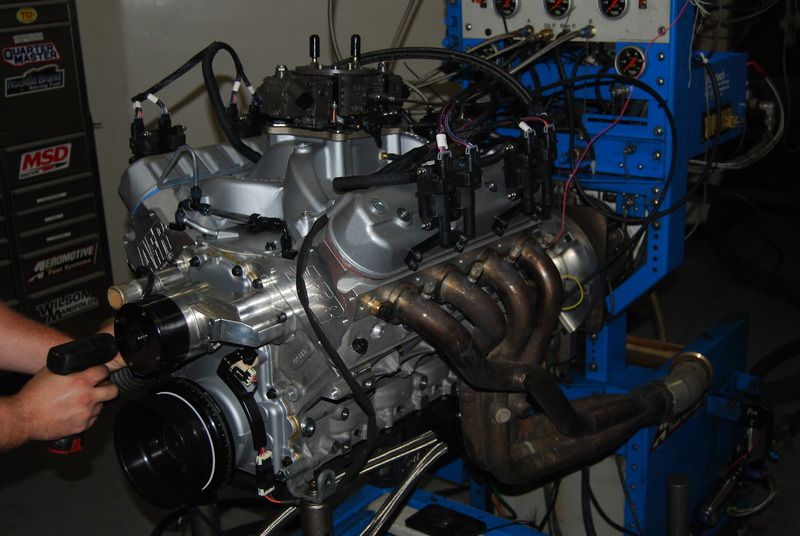 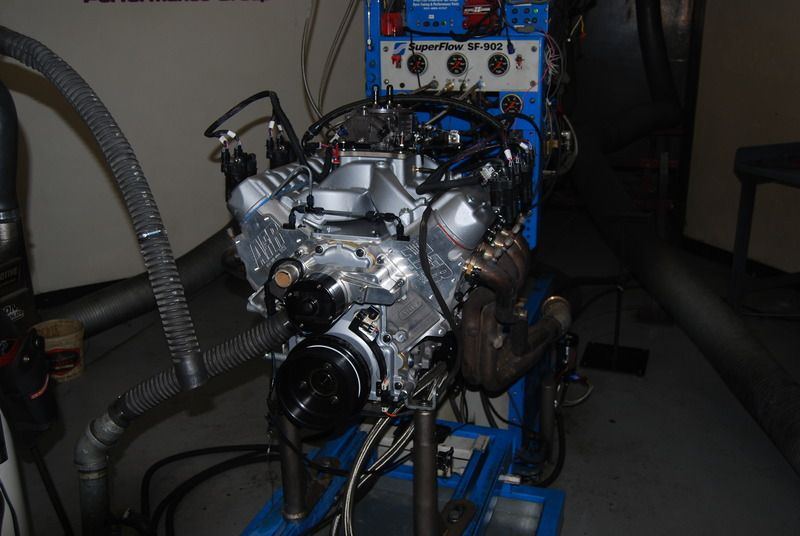 We also had a single plane Edelbrock Victor on hand, but we did not have the time to test it. The baseline test used an Edelbrock Performer dual plane intake for all pulls. The plan was to start with the carb and run the engine break in with a known good dyno carb. The engine fired up immediately, almost instantly. We ran a brief break in, and set up the multi-channel sensors. Unfortunately, we damaged one of the O2 bungs and were only able to run 7 channels, so cylinder # 8 does not get an O2 reading on the AFR plots. O2 Sensors on lower part of the primary tubes:  With the 950 Holley, the engine put out 559 bhp @ 6000 rpm, with a peak torque of 548 lb/ft, pretty flat from 3000-6000 rpm. We made numerous timing and jet changes to optimize the conditions for a best foot forward baseline, and ended up with the best carb pull as seen below. 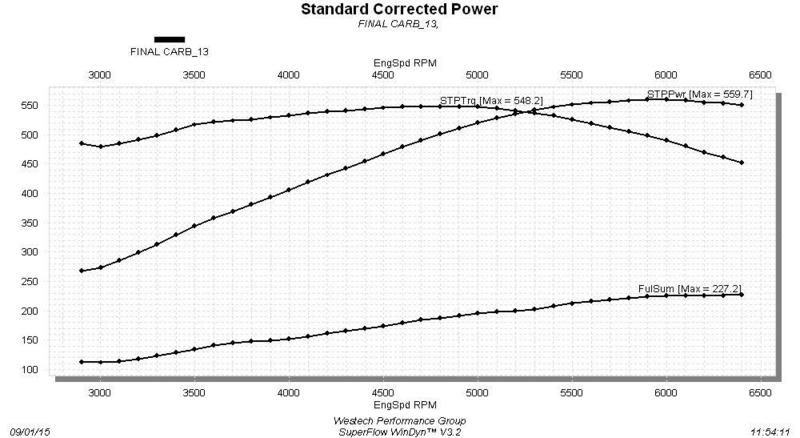 This took us to lunch time, so after lunch we set out to install and start the FITech unit for the first time. It took all of about 15 minutes to switch out the carb for the FITech. 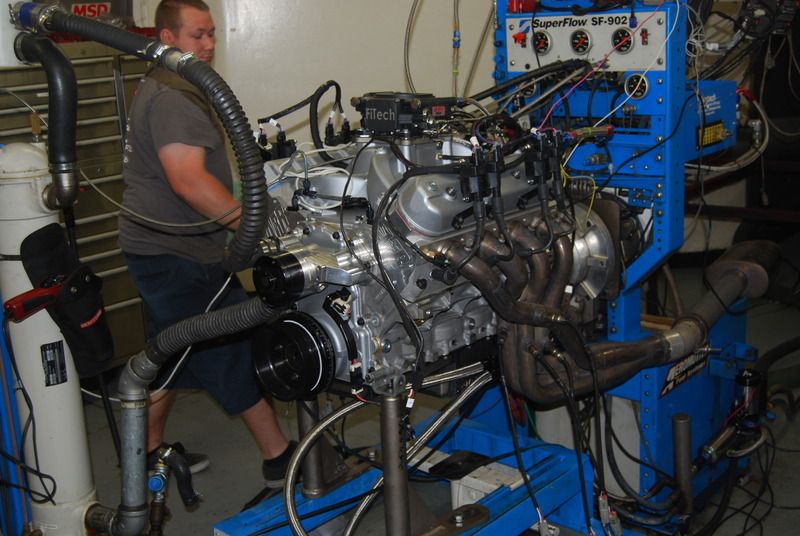 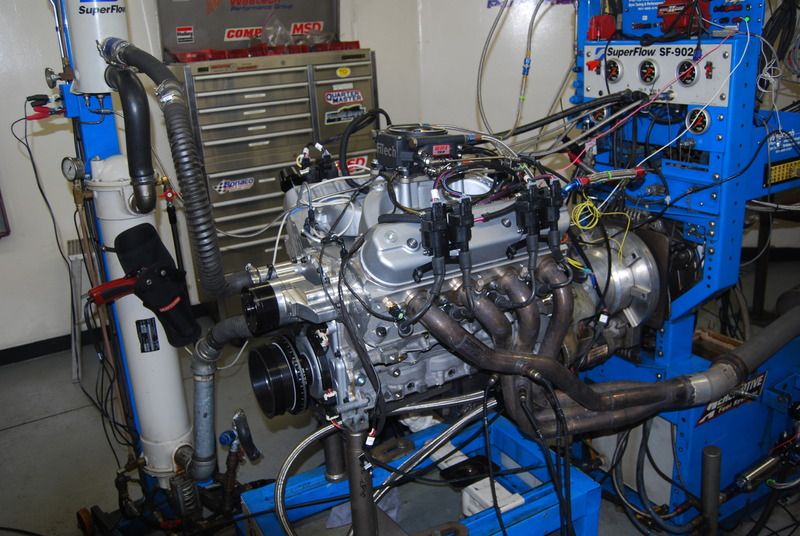 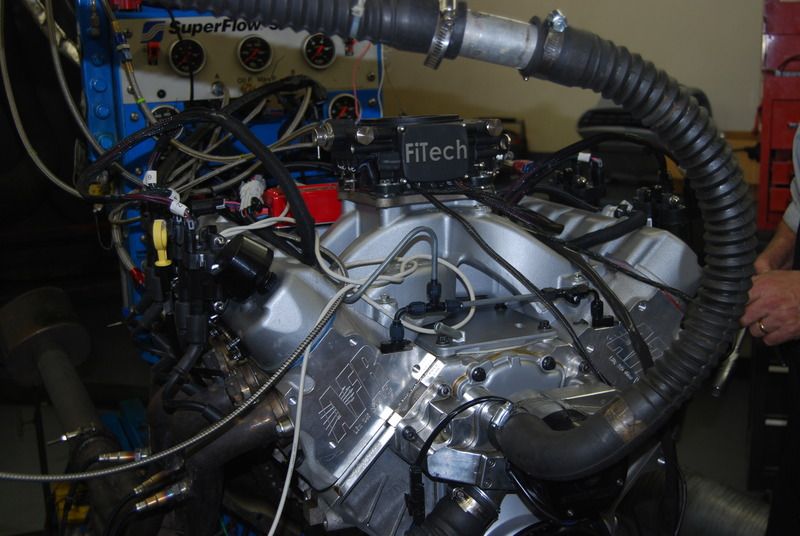 As with the carb, the engine started immediately, but as we watched the first few minutes of running, we could not see any fuel trims or adjustments of any kind. The unit ran OK, but it was not operating in closed loop mode- so no “learning” was taking place. We did not feel that we could make any power pulls with the closed loop mode not working correctly, so we went into trouble shooting mode. We narrowed the possibilities to a faulty O2 sensor, as it did not seem to be heating up. We placed a call to FITech to get their opinion, and as they are located nearby, they suggested they come over to lend a hand. How about that for customer service. They sent Jeremy, their chief engineer over and he arrived with a spare O2 sensor and his laptop, and quickly looked over our install and plugged his computer into the setup. He confirmed that the O2 sensor was not reading, but it turned out the sensor was good but a setting deep inside the calibration tables had the sensor heater turned off. As this setting is not accessible to the user through the touch screen, it is a mystery how this happened, but once turned on the unit went immediately into closed loop and we could see the fuel trims taking place in real time. We ran some partial pulls to get the learning function to update the fuel tables at various loads, and after 15 minutes or so we were ready for full power pulls. The closed loop function learns very quickly. The dyno results were surprising. This chart is a direct overlay comparison of the best carb pull with the best FITech pull:  The FITech tracked the carb pulls very closely, giving up almost nothing at the top end, and to all of our surprise, actually exceeded the carb in midrange torque by about 10 lb/ft. These results were very impressive with respect to power, but as I mentioned, we were also concerned with fuel distribution as this is a known weak point in throttle body EFI. We did see some anomalies in cylinder # 3 going excessively lean, which we did not see with the carb pulls. In general, the carb pulls also showed some variability in cylinder to cylinder AFR, but most of this was down in the lower RPM ranges, once the air velocity speeds up, the carb AFR’s clean up. Not necessarily so with the FITech, as the AFR variability was more pronounced, and additional air speed did not seem to help as much. We went back and looked at the plugs, switched O2 sensors around to see if the lean condition of # 3 followed the sensor (it didn’t), and took another round of tightening up potential air leaks, which seemed to show a slight improvement. In the end, we were reasonably happy that the AFR variability was in hand, although not ideal. 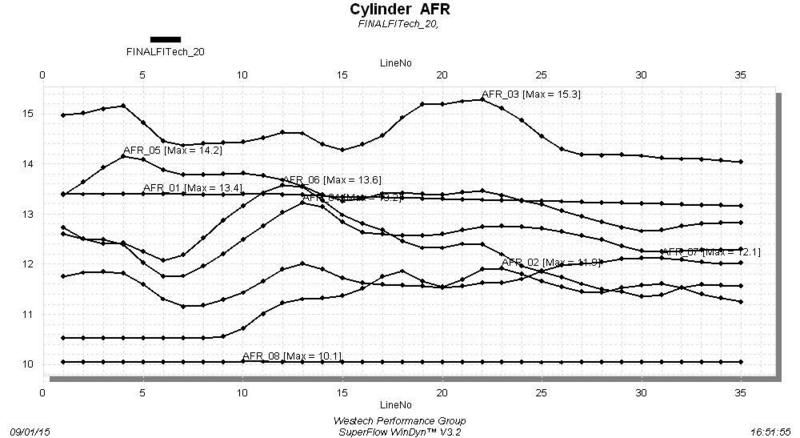 As one might expect, for a max effort engine that is going to see sustained high RPM pulls, a full sequential port EFI is of course a superior system, allowing individual fuel and timing trims- for a lot more money. You would not expect the amount of data scatter that we saw with this system if using a top line multi-port sequential system, but as a replacement for a Q-jet or other retrofit for street or even a street/strip or autocross application, based on what we saw today, I think this represents a very good value and certainly exceeded my expectations.
__________________
1964 Catalina 2+2 4sp, 421 Tri-power 1965 GTO, Roadster Shop chassis, 461, Old Faithful cam, KRE heads 305 CFM, Holley EFI, DIS ignition. 1969 GTO 467, Edelbrock 325 CFM, Terminator EFI 1969 Firebird Convertible |
|
#18
|
|||
|
|||
|
Very nice write up.
Yeah I would have loved to see a comparison with the sequential port EFI too. |
|
#19
|
||||
|
||||
|
Thank you for the update. Your results look great. I am about to pull the trigger on this system for my 650-700 hp street car.
|
|
#20
|
|||
|
|||
|
This makes me feel as if I made a good decision going with the FiTech!
With my Pontiac 400 I do not notice a difference top end, but at idle it has tamed the beast. |
| Reply |
|
|